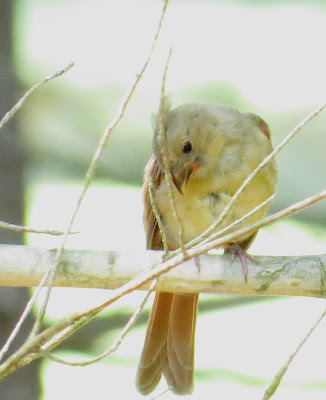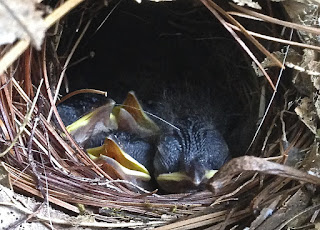This week's weather in the 70s is driving me crazy! It is November; it shouldn't be 70-something. I love fall and I feel like I'm being cheated out of the cool, crisp bite in the air. But more than that, the ticks think it is spring; there are massive numbers of them around, and most are the really tiny deer ticks--I have taken 10-12 off of Blake in the last 5 days. I am looking forward to the weather getting cold and the temperature dropping so that it stays below 40 degrees. 40 (give or take a few degrees) is the point where these nasty bugs go dormant.
Meanwhile, the trees have been very interesting, surprising, (and beautiful!) this week. Monday, I took Blake and we paddled down the pond in search of some fall pictures. I was not disappointed! (All I had was my iPhone, so these pictures were all taken on a phone!)
The oak trees were in their stage of deep reds, golds and browns.
 | ||
| Stearns Mill Pond, Nov 2, 2015 |
| I love the reflection of the clouds in this one |
 | |||
| Stearns Mill Pond, Nov 2, 2015 |
I paddled upstream and startled a flock of ducks; I'm not sure if they were mallards, blacks or wood ducks. Why were my binoculars at home??? The ducks churned up the water as they flew off and it started me looking at the ripples in the water near my canoe.
The water/shore line is at the very top of the page.
The berries on the branches of trees and shrubs feed the birds this time of year. If you are planting in your yard, try to put in some berry producing plants, but be sure to always plant native trees, shrubs and flowers. Ornamental plants from other countries, or even other parts of the US, are pretty, but they often push out the native plants because there are no animals, birds or insects who feed on the plant and help keep it in check (think about how Purple Loosestrife has taken over). When the native plants disappear, so do the birds and animals that depend on them. Put native & local plants in your yard.
I lucked out taking this photo; the very next day, the dogwood next to the house (the red tree, bottom left) had gone into its stage of brown and crumpled leaves. Now, just 5 days later, all of the leaves that belonged to the dogwood are gone and are replaced by oak leaves that didn't quite make it to the ground.
The Monday that I took these pictures (Nov 2) was spectacularly gorgeous in colors, temperature and the feel of the air. Two days later it was hot and all of the leaves had withered and hung limply on the branches. Two days after that, the leaves were in the roadways, driveways and yards!
 |
| Our road |
 |
| Morning Sky, Nov 7, 2015 |
My phone just couldn't get a good picture of the crescent moon with Venus at her side, but the color and shapes are quite striking.
I am grateful that we are off of daylight savings time so that we can enjoy the early morning light again!
I recommend getting out there early and just looking around at all you can see and all that becomes visible as the sun rises. Pretty special.
What do you like about fall? Send comments and pictures to add to this post.





















































